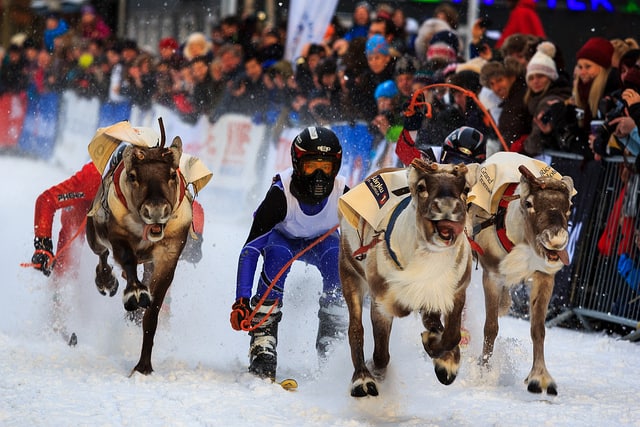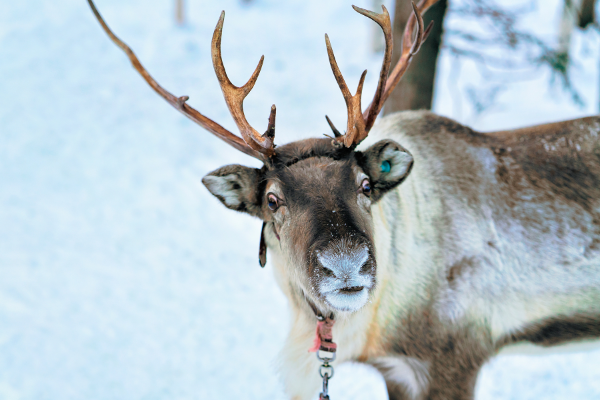FINLAND
Reindeer Racing
By Jenny McGlone
Chapel Hill, NC, United States
Way, way far north, in lands that seem almost too cold for human settlement, a brave few thousand people have made their home. Inari, Finland, is the country’s largest municipality, covering 6,693 square miles, of which 881 is water. Despite its large geographical size, its population density is modest, as Inari claims only 1.2 inhabitants per square mile.
While Inari may not be extravagantly endowed with people, its population carries a rich culture. For example, four official languages are spoken there, three of which came from the indigenous Sámi people. The Sámi have passed along many important traditions.
Sámi Traditions
For at least 5,000 years, the Sámi people have made a living from herding reindeer. In fact, reindeer herding is such an integral part of their culture that some other Scandinavian countries have protected it by law. In Finland, there are 51 reindeer herding cooperatives, many of which take part annually in a reindeer racing championship.
This race occurs in the spring, usually March through April, when Inari is beginning to become the land of the midnight sun. As the hours of sunlight lengthen, skiers and their reindeer match up against each other for the coveted trophies.
Racing
The most common form of this contest places one skier behind one reindeer. These reindeer are usually males selected the previous autumn for their speed potential and competitiveness. The reindeer are trained to run in a harness trailing a rope. The jockey holds onto the rope and tries not to fall. The fastest reindeer can reach speeds of up to 35 miles per hour. Covering a kilometer in under two minutes is easy for these animal athletes.

While some reindeer races take place on snow-covered city streets, the culmination of the racing season occurs on the frozen Lake Inari. This body of water is the third largest lake in Finland and covers 400 square miles. It is usually frozen from November through early June.
In April every year, dozens of reindeer and their professional jockeys gather in the subzero temperatures for a competition that feels also like a festival. The racing is taken very seriously, as the reindeer have their antlers removed and the jockeys wear aerodynamic suits.
The spectators can number in the hundreds, all trying their best to stay warm while cheering on their favorite animals and jockeys. They pay close attention to the weather, and if dark clouds appear, they can be heard to say to one another, “It looks like rain, dear.”
Have a suggestion for this story? We’d love for you to submit it!


Blank
Blank
Slideshow
Are you a math teacher who’s interested in telling this story to your students? Here’s a bilingual slideshow to get you started!
Math Resources
Learning Activities:
- Measurement and Data (Grade 5)
- Connecting to the Standards: Expressions and Equations (Grade 6)
- Geometry (Area of Polygons) (Middle School)
- Ratios and Proportional Reasoning (Middle School)
Sample Problems:
- Given the population density and geographical area mentioned in the story, how many people would you estimate live in the vicinity?
- If the Sámi have been herding reindeer for 5,000 years, in what year did they begin?
- If the fastest reindeer can run at 35 miles per hour, at how many kilometers per hour can they run?
- What is the temperature at which water freezes in Fahrenheit and Celsius?
- If the prize money totals $12,000, and the winning reindeer/jockey team receives 80 percent of that, how much money will the team win?
- Research the size of Lake Inari. How long would it take a reindeer at top speed to run the entire circumference of the lake in both miles per hour and kilometers per second?
- Plan a reindeer race. What expenses do you think you would have? How much would you need to charge spectators and participants to make a profit?
Social Justice Questions
- What is your reaction to reindeer being used to race? Does this seem a humane treatment of animals to you?
- Does it seem fair to you that Norway and Sweden outlaw reindeer herding by any other person other than a member of the Sami? Why or why not?
- Climate change poses a threat to this sport as arctic regions becomes warmer and the reindeer’s habitat is endangered. Research the effects of climate change in northern Finland. What did you learn?
Explore Further
- A documentary on reindeer racing
- Information about the Sámi people here and here
- Photo essay of reindeer racing
- Information about climate change in Finland
- Finland’s resolution to the United Nations to be carbon neutral
Share Your Story
Write your own Global Math Story and send it to us!
Sorry, the comment form is closed at this time.